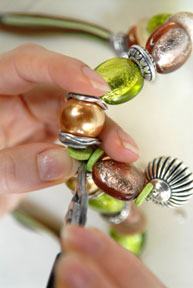y bedroom looks like a jewelry shop. Necklaces, bracelets, and earrings from weekday casual to tea-with-the-Queen dressy cover the nightstand, bookshelves, and dresser. I love making jewelry, but it can be an expensive hobby. (Sterling silver is about $45 per ounce as I write this.) Several years ago, I realized that I needed to figure out a way to make money from my hobby or scale back.
A quick trip to the local bookstore with rows of craft magazines made me realize that I could sell a handmade necklace for $30—or sell the how-to instructions to a magazine for two to five times that amount and still sell the necklace after publication. Since then, I’ve had more than one hundred designs, articles, and essays published in a number of magazines.
Whether you love knitting, scrapbooking, cross-stitch, painting, sewing, card making, jewelry design, or dozens of other crafts, here are seven tips to help you succeed:
1. Take Great Photos
It may seem odd to start a list of tips for writing with photography; but given that craft publications are packed with images, a great photo is the single most important way to increase your acceptance rate.
While you don’t need to be a professional photographer, editors increasingly make acceptances based entirely on a submitted JPG image. Take a photo of your project in good lighting on a plain, uncluttered background, and follow the magazine guidelines for preferred resolution and image format.

Unless a magazine specifies to only send one image, I usually send one shot of the full project and one close-up. (Occasionally, I’ll send a photo of the back of the project if there’s a good reason, such as a reversible necklace pendant.) While the full project shot may intrigue an editor, the close-up allows the editor to see your craftsmanship: Are there lumps of glue seeping out of the sides, sloppy stitches, or stray threads? Your close-up photo assures the editor that your project is well made and won’t fall apart during photography.
Some magazines may also want to see step-by-step photos of your project, either to publish in the magazine or to help the technical editor or illustrator understand your process. For these, it’s helpful to use a tripod to make sure that the images are crisp and all taken from the same perspective.
2. Study the Other Magazines
Of course, you should study the magazines you’d like your projects published in. Look at the projects, materials, techniques, style, and level (beginner, intermediate, advanced). But don’t stop there. It’s helpful to study home decor, lifestyle, and fashion magazines, too. Being able to interpret popular trends (such as the earth-friendly movement) or the upcoming seasonal color palettes can give your work an edge. Knowing the trends doesn’t mean you need to follow them; sometimes you may wish to deliberately go against a trend and send something fresh to the editor.
3. Be Accurate
In writing your how-to project instructions, pay attention to measurements, colors, materials, and brand names. Some magazines are fairly loose in their instructions and may simply direct readers to use “a comfortable length of your favorite thread.” Others are more detailed, specifying, “Three feet of black nylon size D thread.” If you’re unsure, it’s better to include more details, rather than fewer, so that the editor does not need to figure out the details on her own or contact you for more information months later.
When reviewing the magazine you’re submitting to, take note of how basic steps are explained. Many magazines use standard language to explain common techniques. While this may seem uncreative, think of it from the reader’s perspective: How long would it take you to figure out how to bind off the edge on a quilt if every project explained it a different way?
The best way to write accurate instructions is to take notes during the creation phase. It’s also helpful to have someone who doesn’t know the project review your instructions, as they will often catch errors. Reading aloud is another trick.
Being accurate and paying attention to instruction style can literally pay off: some magazines pay on a sliding scale, depending upon how much work it takes them to edit your instructions.

“The craft market is strongly tied to the seasons and holidays, so expect to submit projects four to twelve months in advance.”
4. Submit Early and Often
The craft market is strongly tied to the seasons and holidays, so expect to submit projects four to twelve months in advance. If it’s June, it’s probably too late to submit a Fourth of July project. (You may be able to still sell a Christmas or winter-themed project—if you hurry!) Online, you may have more leeway; but even online publications may work a month or more in advance. Given that holiday-themed craft supplies may not be available year-round, you’ll need to plan ahead.
Most publications will accept multiple submissions. That said, don’t overwhelm them with every project you’ve ever created. As a general rule, the more projects in a single issue, the more projects you might send for consideration. In other words, you might send several projects to a magazine that publishes one hundred in every issue, but only one or two to a magazine that publishes twenty. A good way to figure out how many to send is to look at your sample issue and see if any designers have multiple projects listed.
While craft magazines typically encourage multiple submissions, they frown on simultaneous submissions to competing magazines. In other words, you can’t send out those projects to another magazine until you hear back from the first one.
Also, it’s a bad idea to just send a link to your online shop or website instead of following the submission guidelines. Most editors are too busy to rummage through hundreds of designs that might not fit the scope of their publication.

“Magazines geared towards women and children sometimes accept craft projects.”
5. Join the Family
When you’re studying craft magazines, take note of the publisher. A single publisher publishes many craft magazines. Success at one magazine may mean success at another magazine by the same publisher. Sometimes you may submit to one magazine and automatically be considered for another at the same publisher. You might also receive advance notice about any new magazines from the same publisher.
6. Stretch Beyond the How-To
The how-to project is the bread-and-butter of craft publications; but there are also opportunities to write feature articles, profiles, product and book reviews, short news items, or essays. This can be a great way to break in if you have a stronger writing background than a crafting one. Check the authors of the articles in your sample magazine against the masthead to see which sections might be open to freelancers.
7. Branch Out Beyond the Craft Market
Look beyond the craft magazines for other opportunities to publish your work. Magazines geared towards women and children sometimes accept craft projects. Business publications may feature successful artists turned business owners. Even a bad experience with crafting can inspire a sale. One of my early sales in this market was a humorous essay about my failure as a knitter to the Knit Lit 3 anthology.
Publishing in the craft world opens doors to many other opportunities. I’ve seen other crafters land book contracts, teaching assignments, product design opportunities, and TV appearances. I’ve not only surpassed my original goal of earning enough to pay for my hobby, but I’ve also started a successful freelance writing and editing career. Now I just need to find more room to store my ever-expanding collection of supplies and designs!
“I’ve seen other crafters land book contracts, teaching assignments, product design opportunities, and TV appearances.”
Seven Craft Markets to Try
This round-up of markets shows the variety of publication opportunities available. It’s worthwhile to make a trip to a local bookstore or craft store to find additional publications on your crafting specialty.
In addition to paid opportunities, some craft publications publish photos or tips by readers in return for a complimentary copy of the magazine. Some also run contests, publishing winning designs and instructions, along with awarding prizes in cash and merchandise. Read guidelines carefully to make sure you’re submitting your work to the right section.
Country Woman
www.countrywomanmagazine.com
Crafts for women who live in or long for the country
Submission guidelines: www.countrywomanmagazine.com/Misc_Pages/cGuidelines.asp
Pay: $50-$150
Crafts Editor: Shalana Frisby, editors[at]countrywomanmagazine[dot]com
craftbits.com
www.craftbits.com
Resources for teachers, therapists, and craft enthusiasts
Submission guidelines: www.craftbits.com/crafts/submissions
Pay: $45 maximum
Editor: Shellie Wilson, staff[at]craftbits[dot]com
Fons & Porter Love of Quilting
www.fonsandporter.com
Original and traditional quilt patterns
Submission guidelines: www.fonsandporter.com/aspx/FonsandPorter/fp/submissions/guidelines.aspx
Pay: $200
Editor: Jean Nolte, snail mail submissions only
Highlights for Children
www.highlights.com
Children's crafts made with inexpensive materials
Submission guidelines: www.highlights.com/contributor-guidelines
Pay: $25 and up
Editor: Christine French Cully, christine[at]highlights[dot]com (submissions by snail mail only)
Paper Crafts Magazine
www.papercraftsmag.com
Cards, tags, gift packaging, and other paper creations
Submission guidelines: www.papercraftsmag.com/submissions/index.html
Pay: $100 and up
Editor: Jennifer Schaerer, submissions via web form (must register first)
Sew News
www.sewnews.com
Personalized ready-to-wear and original fashions, accessories, and home decor
Submission guidelines: www.sewnews.com/about/write_for_us.html
Pay: $50 and up
Editor: Ellen March, sewnews[at]sewnews[dot]com
Simply Handmade
www.northridgepublishing.com/handmade_current.html
Stylish home decor, cards, gifts
Submission guidelines: www.northridgepublishing.com/submissions.html
Pay: Product samples and two complimentary issues
Editor: Tammy Morrill, creations[at]northridgepublishing[dot]com
Stringing
www.stringingmagazine.com
Fashionable necklaces, bracelets, and earrings made with simple stringing, wirework, and knotting techniques.
Submission guidelines: www.stringingmagazine.com/contributors.asp
Pay: $15-$60
Editor: Danielle Fox, stringingsubmissions[at]interweave[dot]com
***

Michelle Mach is a full-time writer and editor in Colorado. More than one hundred of her original designs and articles have appeared in a number of magazines, including Beadwork, Creative Jewelry, Interweave Crochet, Simply Handmade, Stringing, and other publications. She was the founding editor of the popular online newsletter, Beading Daily, and is currently a contributing editor for Beadwork. Learn more at www.michellemach.com.
-----
Recommended Resource: Want to learn more about writing for the craft market? Try WOW!’s new class: How to Write a Craft Book